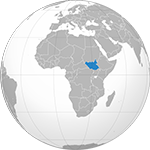Overview
Since December 2013, South Sudan has experienced intermittent civil war and intercommunal and localised violence. This environment has resulted in widespread insecurity, large-scale internal displacement, increased refugee outflow to Sudan and Uganda, and deteriorating food security. As at January 2021, 8.3 million people were in need of humanitarian assistance.?
The latest peace agreement in South Sudan – the Revitalised Agreement on the Resolution of Conflict in South Sudan – was signed in 2018. The agreement has led to a fragile truce and resulted in the formation of the Transitional Government of National Unity in February 2020. While hostility between the Government and the main opposition has decreased, localised violence has surged because of conflict over land and resources, cattle raiding, and reprisal attacks.?
The surge in intercommunal violence throughout South Sudan affected more civilians in 2020 than in 2019. There were 5,800 victims of killing, injury, abduction, and conflict-related sexual violence in 2020 – an increase from the 2,631 victims reported in 2019. In 2020, Jonglei state and the Greater Pibor Administrative Area were most affected by conflict, accounting for 33% of the total civilian victims. The compounded effects of intercommunal violence and floods in these areas affected 528,000 people and displaced at least 147,000 people as at the end of 2020.?
Since 2013, nearly four million people have been displaced, including 1.6 million IDPs and 2.2 million South Sudanese refugees. South Sudan hosts about 319,000 refugees from Sudan, the Democratic Republic of Congo, Ethiopia, and the Central African Republic.?
INFORM estimates South Sudan's humanitarian crisis and disaster risk for 2021 to be very high, at 8.4/10. The lack of coping capacity is estimated at 9.4/10, and vulnerability is estimated at 8.7/10. ?
Latest Developments
No significant recent humanitarian developments. This crisis is being monitored by our analysis team.
Key Figures
INFORM Global Crisis Severity Index
Crisis Severity: 4.3
Impact: 4.7
Humanitarian Conditions: 4.5
Complexity: 3.6
Access Constraints: 2
Information courtesy of ACAPS. https://www.acaps.org/
Key Figures - 2021 HPC
in need
reached
Objectives
- Ensure a protective environment in camps and camp like settings for the displaced population and host.
- Ensures predictable and coordinated delivery of service, provision of information aimed at improving the quality of integrated services for the displaced populations in camps and camp like settings.
- Representation and Governance structures are established to promote the camp population’s participation in decision making and issues which affect their lives.
- Strengthen community coping mechanisms geared towards finding solutions.
| Title | Uploaded |
|---|---|
| South Sudan CCCM Cluster Strategy 2018 - 2019 | 01 Mar 2019 |
| South Sudan GBV Report | 14 Aug 2018 |
| CCCM Cluster South Sudan - Terms of Reference | 23 Jan 2014 |
| Title | Posted on |
|---|---|
| South Sudan | CCCM Cluster Bi-weekly Situation Report | 16 - 30 September 2018 | Mon, 15/10/2018 - 14:43 |
| South Sudan | Fuel Efficient Stoves | Thu, 04/10/2018 - 15:38 |
| South Sudan | Fuel Efficient Stoves | Thu, 04/10/2018 - 15:37 |
| South Sudan | Fuel Efferent Effective Stoves | Thu, 04/10/2018 - 15:36 |
| South Sudan | CCCM Cluster Bi-weekly Situation Report | 01 - 15 September 2018 | Sun, 23/09/2018 - 11:59 |
14 Common Operating Datasets or CCCM-tagged datsets are on the Humanitarian Data Exchange:
- South Sudan - Internally displaced persons - IDPs - IDMC - [2011-01-01T00:00:00 TO 2020-12-31T23:59:59]
- South Sudan Population Movement - [Migrants] - [IOM DTM] - International Organization for Migration - [2021-02-01T00:00:00 TO 2021-02-28T23:59:59]
- South Sudan Displacement Data - [IDPs, Returnees] - Emergency Event Tracking [IOM DTM] - International Organization for Migration - [2020-01-01T00:00:00 TO 2020-12-31T23:59:59]
- Eastern and Southern Africa Humanitarian Situation and Response - UNICEF ESARO - [2020-01-01T00:00:00 TO 2020-12-31T23:59:59]
- South Sudan Displacement - [IDPs, Returnees] - Baseline Assessment [IOM DTM] - International Organization for Migration (IOM) - [2020-07-01T00:00:00 TO 2020-09-30T23:59:59]
- South Sudan - Subnational Population Statistics - FSNMS [Food Security and Nutrition Monitoring Systems], South Sudan National Bureau of Statistics [SSNBS], OCHA, IPC Technical Working Group, Population Working Group [SSPWG], IOM and UNHCR - [2020-11-03T00:00:00 TO *]
- Eastern and Southern Africa Risk Analysis - UNICEF ESARO - [2020-10-31T00:00:00 TO 2020-10-31T23:59:59]
- Eastern and Southern Africa Refugees and IDPs Situation and Response - UNICEF ESARO - [2019-12-31T00:00:00 TO 2019-12-31T23:59:59]
- South Sudan Displacement Data - Site Assessment [IOM DTM] - International Organization for Migration (IOM) - [2020-02-01T00:00:00 TO 2020-03-31T23:59:59]
- South Sudan - Subnational Administrative Boundaries - South Sudan Information Management Working Group (IMWG), National Bureau of Statistics (NBS), and OCHA - [2018-08-15T00:00:00 TO *]

